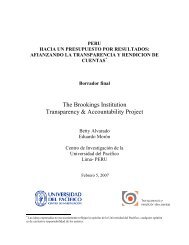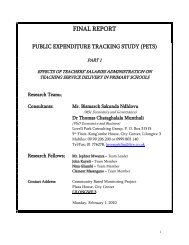Provider Purchasing and Contracting for Health Services_The Case
Provider Purchasing and Contracting for Health Services_The Case
Provider Purchasing and Contracting for Health Services_The Case
Create successful ePaper yourself
Turn your PDF publications into a flip-book with our unique Google optimized e-Paper software.
• Budgetary re<strong>for</strong>m whereby District <strong>Health</strong> Management Boards received allocation<br />
from the central authorities to enable them to plan <strong>and</strong> manage their affairs more<br />
effectively<br />
• Introduction of user fees to enhance the resource base of District <strong>Health</strong> Management<br />
Boards<br />
• Introduction of basket funding whereby cooperating partners’ funds would be put in<br />
one basket <strong>and</strong> used in accordance with the government’s priorities<br />
• Emphasis on primary health care with a focus on prevention <strong>and</strong> promotion of<br />
strategies <strong>for</strong> health care service delivery<br />
<strong>The</strong> objectives of these re<strong>for</strong>ms were to address the inequalities, inefficiencies, <strong>and</strong><br />
ineffectiveness of the health care sector to make it more responsive to community, household,<br />
<strong>and</strong> consumer needs. Thus, community health structures, such as neighborhood health<br />
committees, were established at health centers. <strong>The</strong>se were to be essential players in<br />
planning, priority setting, <strong>and</strong> decision making at the lowest point of health care services.<br />
Re<strong>for</strong>ms were structural, institutional, <strong>and</strong> systemic in nature. Decentralization was seen as<br />
the vehicle through which constraints to access could be addressed. It was based on a<br />
delegated model of power decentralization. This was attained through the <strong>for</strong>mation of health<br />
boards. <strong>Health</strong> boards were created at all levels of the health system, leading to the <strong>for</strong>mation<br />
of District <strong>Health</strong> Boards at the primary health service level <strong>and</strong> Hospital Management<br />
Boards at the secondary <strong>and</strong> tertiary levels.<br />
<strong>The</strong> 1995 National <strong>Health</strong> Service Act initiated significant changes in the role <strong>and</strong> structure<br />
of the Ministry of <strong>Health</strong> <strong>and</strong> called <strong>for</strong> the establishment of an essentially autonomous health<br />
service delivery system. <strong>The</strong> Directorate of Medical <strong>Services</strong> in the Ministry of <strong>Health</strong> was<br />
replaced by the semi-autonomous Central Board of <strong>Health</strong>, which was to “monitor, integrate,<br />
<strong>and</strong> coordinate the programs of the <strong>Health</strong> Management Boards, set financial objectives <strong>and</strong><br />
the framework <strong>for</strong> management boards <strong>and</strong> to provide technical consultancy to management<br />
boards <strong>and</strong> assist non-Government health providers in their delivery of health services”.<br />
Meanwhile, the “new” Ministry of <strong>Health</strong> was to be primarily a policymaking <strong>and</strong> regulatory<br />
institution, <strong>and</strong> its directorates were reduced to three: Human Resources <strong>and</strong> Administration,<br />
Planning <strong>and</strong> Development, <strong>and</strong> <strong>Health</strong> Policy. It remained responsible <strong>for</strong> policy<br />
<strong>for</strong>mulation, strategic planning, coordination, legislation, budgeting <strong>and</strong> resource<br />
mobilization, <strong>and</strong> external relations. At the same time, a broad purchaser-provider split<br />
between the Ministry of <strong>Health</strong> as purchaser of services <strong>and</strong> the autonomous boards as health<br />
service providers was created. <strong>The</strong> Ministry of <strong>Health</strong> funded the Central Board of <strong>Health</strong>,<br />
while individual district <strong>and</strong> hospital boards signed annual service contracts with the Central<br />
Board of <strong>Health</strong> in which they undertook to provide a range of specified services to a given<br />
population in return <strong>for</strong> monthly grants from the government <strong>and</strong> cooperating partners (MoH<br />
1998b).<br />
Table 2: Roles <strong>and</strong> responsibilities of the MoH <strong>and</strong> CBoH after the 1995 NHS Act<br />
re<strong>for</strong>ms<br />
Key Function or Responsible Institution Rationale (comment)<br />
Responsibility<br />
CBoH<br />
MoH<br />
Human resource Operational Planning <strong>for</strong> CBoH maintained the<br />
11
















